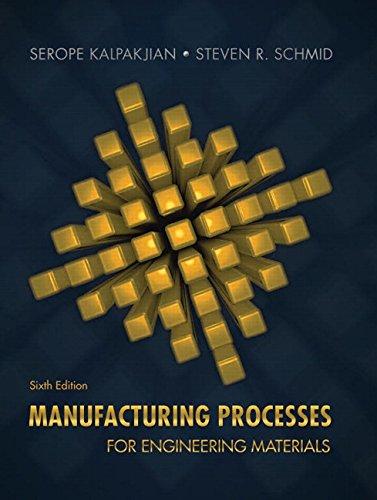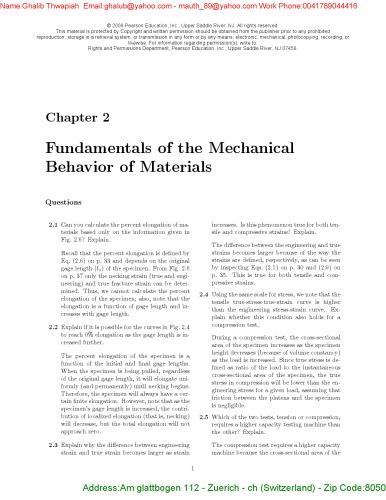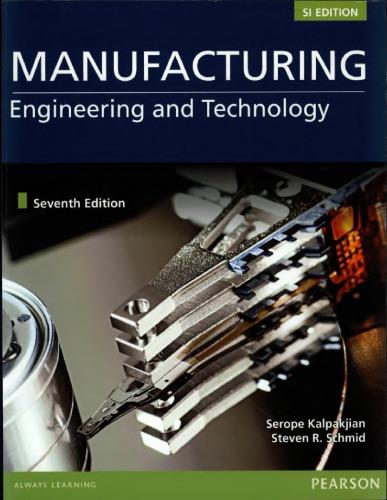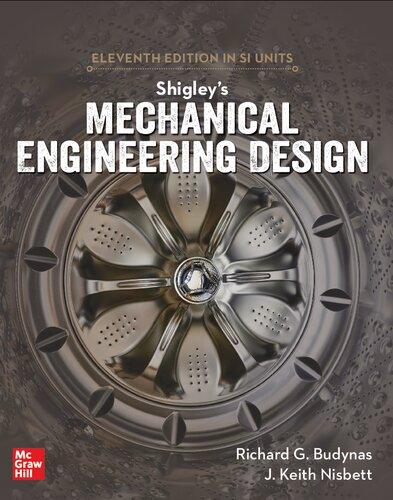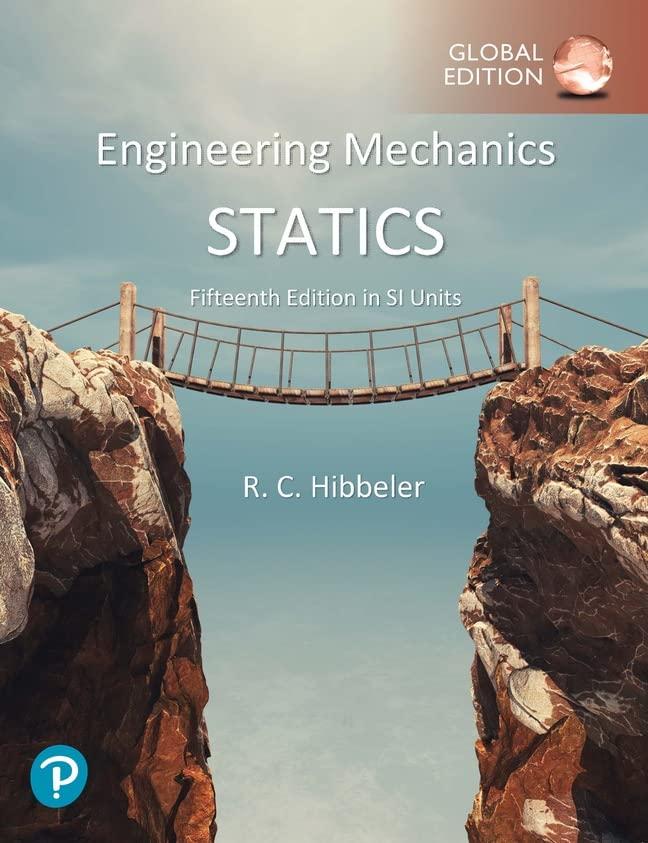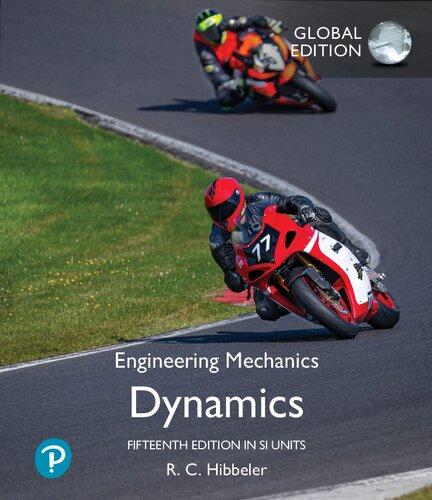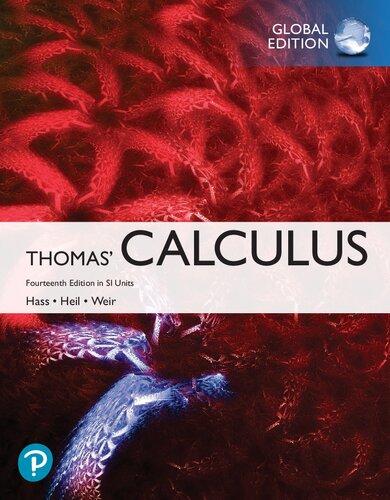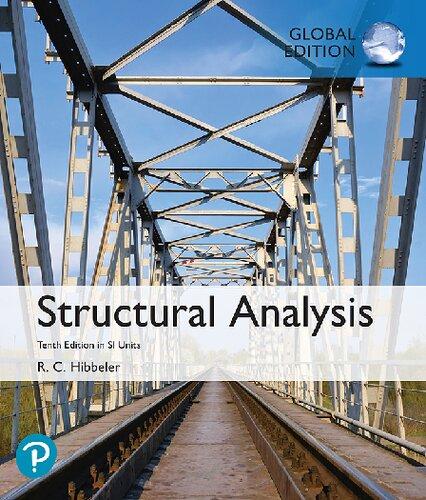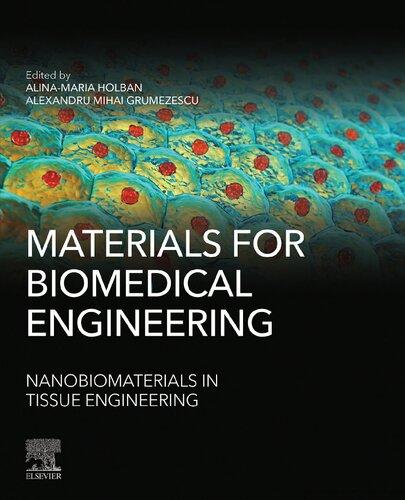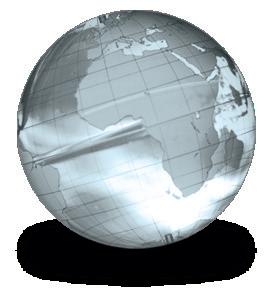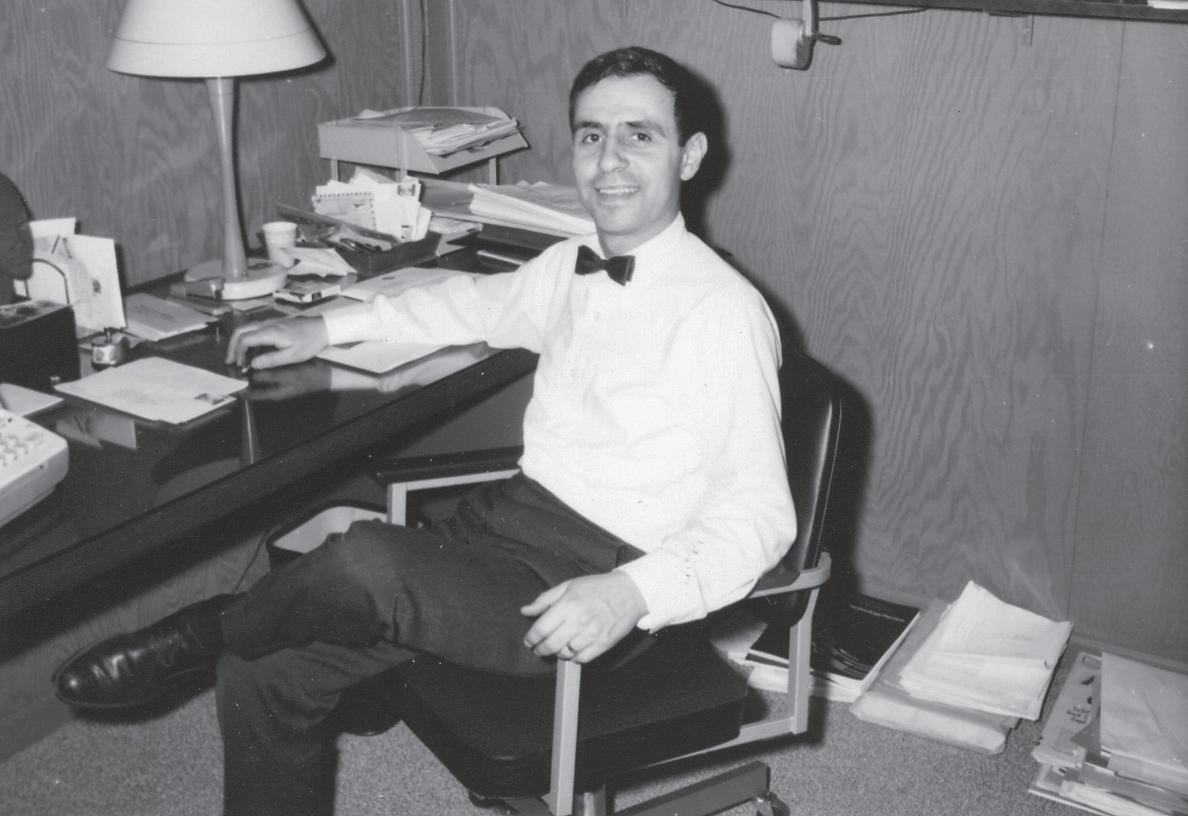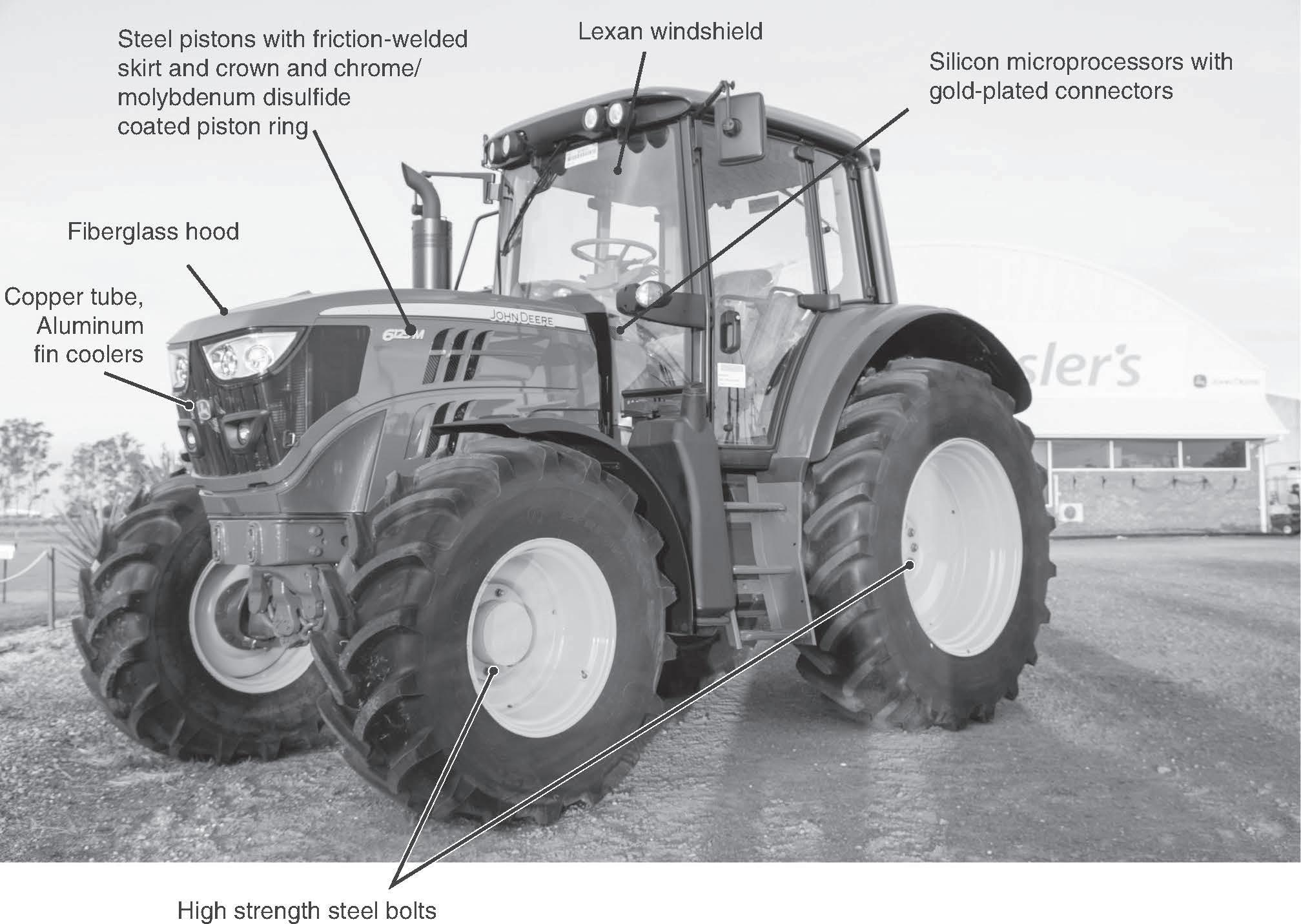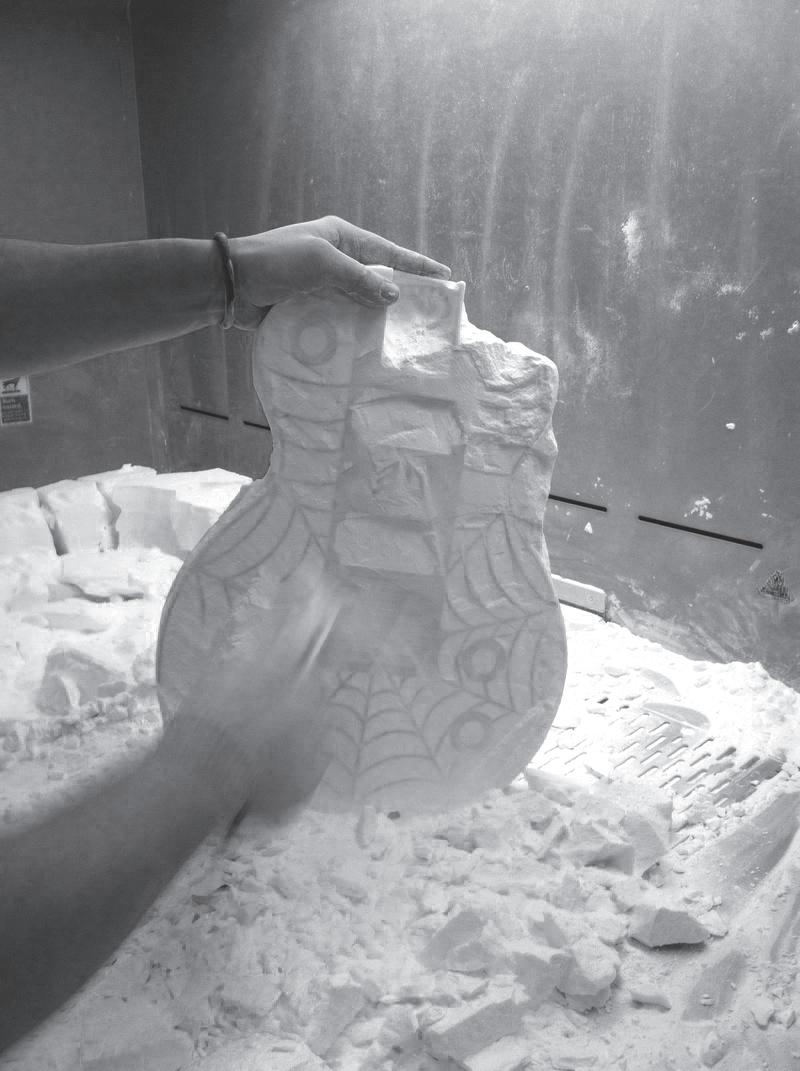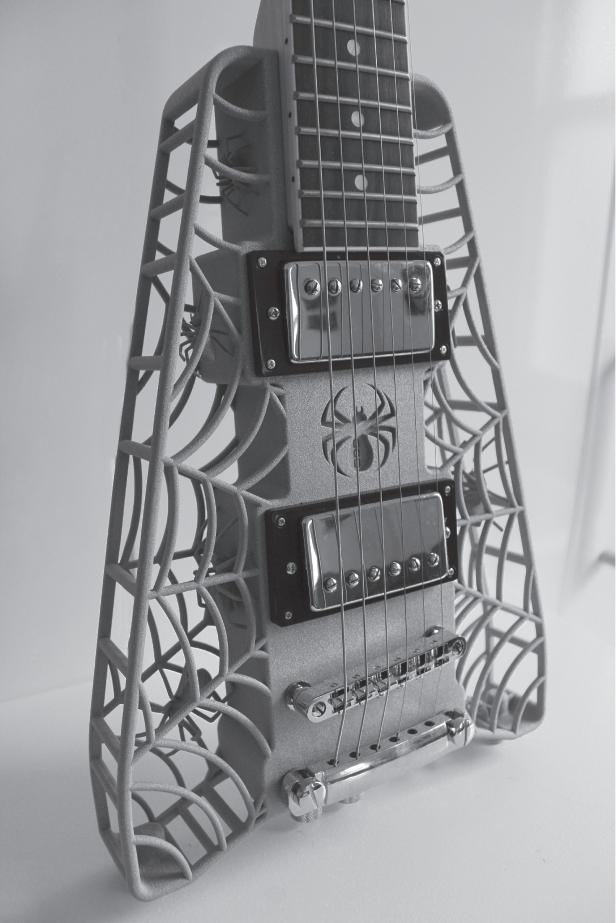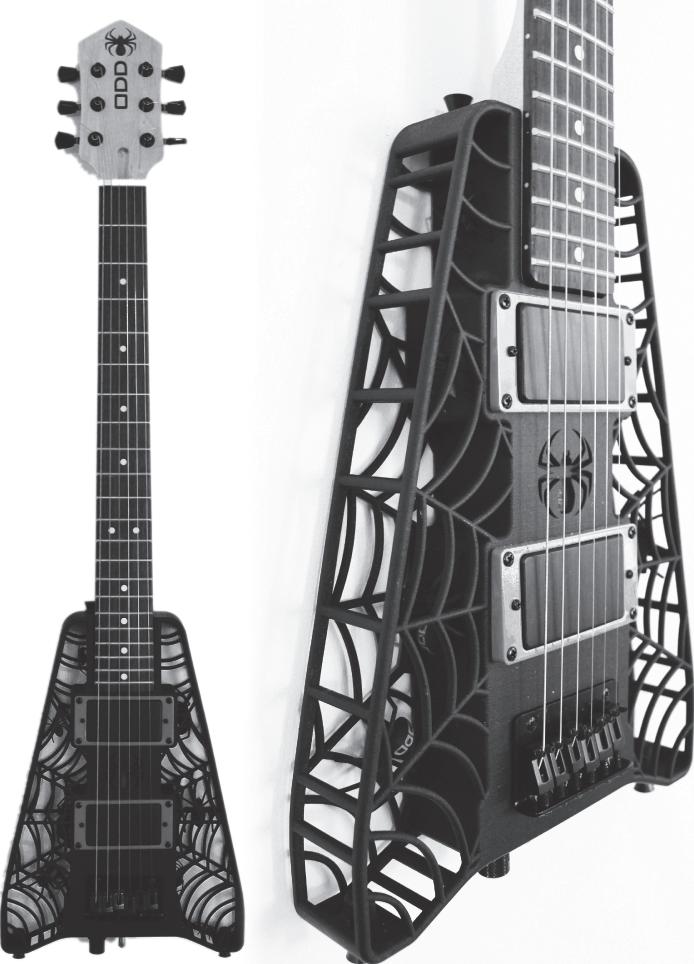Visit to download the full and correct content document: https://ebookmass.com/product/manufacturing-processes-for-engineering-materials-in -si-units-6th-ed-serope-kalpakjian/
More products digital (pdf, epub, mobi) instant download maybe you interests ...
Manufacturing Processes for Engineering Materials (5th Edition)-Solution Manual Serope Kalpakjian
https://ebookmass.com/product/manufacturing-processes-forengineering-materials-5th-edition-solution-manual-seropekalpakjian/
Manufacturing Engineering and Technology 7th Edition Serope Kalpakjian
https://ebookmass.com/product/manufacturing-engineering-andtechnology-7th-edition-serope-kalpakjian/
Shigley's Mechanical Engineering Design in SI Units (11th Ed.) 11th Edition Richard Budynas
https://ebookmass.com/product/shigleys-mechanical-engineeringdesign-in-si-units-11th-ed-11th-edition-richard-budynas/
Engineering Mechanics: Statics, SI Units, 15th Edition
Russell Hibbeler
https://ebookmass.com/product/engineering-mechanics-statics-siunits-15th-edition-russell-hibbeler/
Engineering Mechanics: Dynamics, SI Units 15th Edition
Russell Hibbeler
https://ebookmass.com/product/engineering-mechanics-dynamics-siunits-15th-edition-russell-hibbeler/
Thomas' Calculus in SI Units 14th Edition Hass
https://ebookmass.com/product/thomas-calculus-in-si-units-14thedition-hass/
Structural Analysis in SI Units 10th Edition Hibbeler
https://ebookmass.com/product/structural-analysis-in-siunits-10th-edition-hibbeler/
Introductory Chemistry, 7th Edition in SI Units Tro N.J.
https://ebookmass.com/product/introductory-chemistry-7th-editionin-si-units-tro-n-j/
Materials for Biomedical Engineering: Nanobiomaterials in Tissue Engineering 1st Edition Alina-Maria Holban
https://ebookmass.com/product/materials-for-biomedicalengineering-nanobiomaterials-in-tissue-engineering-1st-editionalina-maria-holban/
SIXTH EDITION IN SI
Serope Kalpakjian • Steven R. Schmid
Digital Resources for Students Your new textbook provides 12-month access to a companion Web site that includes several manufacturing videos.
Follow the instructions below to register for the companion Web site for Kalpakjian and Schmid’s Manufacturing Processes for Engineering Materials, Sixth Edition in SI Units.
1. Go to www.pearsonglobaleditions.com.
2. Enter the title of your textbook or browse by author name.
3. Click Companion Website.
4. Click Register and follow the on-screen instructions to create a login name and password.
ISSEPM-PRINK-WOVEN-SPITE-NADIR-RUNES Use the login name and password you created during registration to start using the online resources that accompany your textbook.
IMPORTANT: This prepaid subscription does not include access to the Pearson eText, which is available at www.plus.pearson.com for purchase.
This access code can only be used once. This subscription is valid for 12 months upon activation and is not transferable. If the access code has already been revealed it may no longer be valid.
For technical support, go to https://support.pearson.com/getsupport.
Manufacturing Processesfor Engineering Materials SIXTH EDITION INSIUNITS
SeropeKalpakjian
StevenR.Schmid
SIContributionsby K.S.VijaySekar
Product Management: Gargi Banerjee and K. K. Neelakantan
Content Strategy: Shabnam Dohutia, Aurko Mitra, and Shahana Bhattacharya
Product Marketing: Wendy Gordon, Ashish Jain, and Ellen Harris
Supplements: Bedasree Das
Production and Digital Studio: Vikram Medepalli, Naina Singh, and Niharika Thapa
Rights and Permissions: Rimpy Sharma and Akanksha Bhatti
Cover image: Shutterstock/sergua
Please contact https://support.pearson.com/getsupport/s/ with any queries on this content.
PearsonEducationLimited
KAO Two KAO Park Hockham Way Harlow CM17 9SR
United Kingdom
and Associated Companies throughout the world
VisitusontheWorldWideWebat: www.pearsonglobaleditions.com
© Pearson Education Limited 2023
The rights of Serope Kalpakjian and Steven R. Schmid to be identified as the authors of this work have been asserted by them in accordance with the Copyright, Designs and Patents Act 1988.
Authorized adaptation from the United States edition, entitledManufacturingProcessesforEngineeringMaterials, 6th Edition, ISBN 978-0-13-429055-3 by Serope Kalpakjian and Steven R. Schmid published by Pearson Education © 2017.
All rights reserved. No part of this publication may be reproduced, stored in a retrieval system, or transmitted in any form or by any means, electronic, mechanical, photocopying, recording or otherwise, without either the prior written permission of the publisher or a license permitting restricted copying in the United Kingdom issued by the Copyright Licensing Agency Ltd, Saffron House, 6–10 Kirby Street, London EC1N 8TS. For information regarding permissions, request forms and the appropriate contacts within the Pearson Education Global Rights & Permissions department, please visit www.pearsoned.com/permissions/.
Many of the designations by manufacturers and seller to distinguish their products are claimed as trademarks. Where those designations appear in this book, and the publisher was aware of a trademark claim, the designations have been printed in initial caps or all caps.
The author and publisher of this book have used their best efforts in preparing this book. These efforts include the development, research, and testing of theories and programs to determine their effectiveness. The author and publisher make no warranty of any kind, expressed or implied, with regard to these programs or the documentation contained in this book. The author and publisher shall not be liable in any event for incidental or consequential damages with, or arising out of, the furnishing, performance, or use of these programs.
PEARSON and ALWAYS LEARNING are exclusive trademarks owned by Pearson Education, Inc. or its affiliates in the U.S. and/or other countries.
MATLAB® is a registered trademark of The MathWorks, Inc., 3 Apple Hill Drive, Natick, MA 01760-2098.
Unless otherwise indicated herein, any third-party trademarks that may appear in this work are the property of their respective owners and any references to third-party trademarks, logos or other trade dress are for demonstrative or descriptive purposes only. Such references are not intended to imply any sponsorship, endorsement, authorization, or promotion of Pearson’s products by the owners of such marks, or any relationship between the owner and Pearson Education, Inc. or its affiliates, authors, licensees, or distributors.
This eBook may be available as a standalone product or integrated with other Pearson digital products like MyLab and Mastering. This eBook may or may not include all assets that were part of the print version. The publisher reserves the right to remove any material in this eBook at any time.
ISBN 10 (print): 1-292-25438-6
ISBN 13 (print): 978-1-292-25438-8
ISBN 13 (uPDF eBook): 978-1-292-25441-8
British Library Cataloguing-in-Publication Data
A catalogue record for this book is available from the British Library
Dedication WhatcanbesaidaboutSeropeKalpakjian?
Heisagiantofmanufacturingresearch,publishing,andeducation. (“ButIamsosmall,”hewouldsay,“fartoosmalltobeagiant.”)
Hehaswrittentheworld’smostpopulartextbookforoverthreegenerationsandhashadmoreinfluenceontrainingengineersthananyone.He haswontheASMandSMEGoldMedals,indicatingthehighesteemthat professionalsocietiesholdforhim,yetheremainshumble.
Universallybeloved,Seropecanworkaroom,whetherit’sfilledwith engineers,scientists,philosophers,orpoets.(Nooneisperfect,hereminds us.)Everyoneishisfriend,justasheiseveryone’sfriend.
Heisaphenomenalspeaker.Iknowofnootherpersonthathasbeen askedtogivethecommencementaddressathisownuniversity.Hewas askedtogiveaFounder’sLectureatanNAMRCConference,andtoldhe couldspeakofwhateverhewished:hislifeasaprofessor,his40yearsof writing,hisdecadesofinnovativeteaching,hiscutting-edgeresearch;but heonlyhad30minutes.(“30minutes?I’lljustspeakslowly,”hesays.)
Heisadevotedhusbandandfather,interestedandinvolved.Hischildrenandgrandchildrenhaveexcelledinlife—thisisperhapsthegreatest measureofman.(“Ihatedthatheaskedmathquestionsatdinner,”complainshisdaughter—aprofessorattheUniversityofMichigan.)Always patientandcaring,heexcelledatadvisingstudentsandmentoringfaculty. Especiallycoauthors.Especiallyme.(“Bookauthorsmakemuchlessthan thosethatthrowaballforaliving,”helamented.)
Therearesomepeople,unfortunatelyaveryfew,thatyoumeetinyour lifethatyoutreasuretheircompanyandrealizethattheyaregenuinely great;peoplethathavealastinginfluenceonyourlife;peoplethatareyour life-longfriends.Therearesomepeoplethatyoucanholdasarole-model andnotbedisappointed.
That’sSerope.
Sincerely,
StevenSchmid
This page is intentionally left blank
AbouttheAuthors17 1 Introduction19
1.1WhatIsManufacturing?19
1.2ProductDesignandConcurrentEngineering25
1.3DesignforManufacture,Assembly,Disassembly,and Service28
1.4EnvironmentallyConsciousDesign,SustainableManufacturing,andProductLifeCycle30
1.5SelectingMaterials32
1.6SelectingManufacturingProcesses36
1.7Computer-IntegratedManufacturing40
1.8LeanProductionandAgileManufacturing42
1.9QualityAssuranceandTotalQualityManagement43
1.10ManufacturingCostsandGlobalCompetitiveness44
1.11GeneralTrendsinManufacturing46
2 FundamentalsoftheMechanicalBehavior ofMaterials48
2.1Introduction49
2.2Tension50
2.3Compression65
2.4Torsion68
2.5Bending70
2.6Hardness71
2.7Fatigue76
2.8Creep77
2.9Impact79
2.10ResidualStresses79
2.11YieldCriteria83
2.12WorkofDeformation90 Summary94Bibliography97Questions98 Problems100
3 StructureandManufacturingProperties ofMetals104 3.1Introduction104
3.2TheCrystalStructureofMetals105
3.3DeformationandStrengthofSingleCrystals107
3.4GrainsandGrainBoundaries113
3.5PlasticDeformationofPolycrystallineMetals116
3.6Recovery,Recrystallization,andGrainGrowth117
3.7Cold,Warm,andHotWorking119
3.8FailureandFracture119
3.9PhysicalProperties126
3.10GeneralPropertiesandApplicationsofFerrous Alloys131
3.11GeneralPropertiesandApplicationsofNonferrous MetalsandAlloys138 Summary152Bibliography153Questions154 Problems156
4
Tribology,Metrology,andProduct Quality157 4.1Introduction158
4.2SurfaceStructureandProperties158
4.3SurfaceTextureandRoughness160
4.4Tribology:Friction,Wear,andLubrication164
4.5SurfaceTreatments,Coatings,andCleaning176
4.6EngineeringMetrologyandInstrumentation189
4.7DimensionalTolerances195
4.8TestingandInspection196
4.9QualityAssurance199 Summary208Bibliography210Questions211 Problems212
5 CastingProcessesandHeat Treatment214 5.1Introduction214
5.2SolidificationofMetals215
5.3CastStructures222
5.4FluidFlowandHeatTransfer227
5.5MeltingPracticeandFurnaces235
5.6CastingAlloys237
5.7IngotCastingandContinuousCasting244
5.8Expendable-Mold,Permanent-PatternCasting Processes246
5.9Expendable-Mold,Expendable-PatternCasting Processes254
6 5.10Permanent-MoldCastingProcesses258
5.11HeatTreatment269
5.12DesignConsiderations280
5.13EconomicsofCasting289
Summary292Bibliography294Questions294 Problems296Design299
BulkDeformationProcesses302 6.1Introduction303
6.2Forging303
6.3Rolling328
6.4Extrusion349
6.5Rod,Wire,andTubeDrawing363
6.6Swaging373
6.7Die-ManufacturingMethods374
6.8DieFailures376
6.9EconomicsofBulkForming377
Summary380Bibliography383Questions383 Problems385Design390
7 SheetMetalProcesses391 7.1Introduction392
7.2SheetMetalCharacteristics392
7.3Shearing397
7.4BendingofSheetandPlate407
7.5MiscellaneousFormingProcesses420
7.6DeepDrawing437
7.7SheetMetalFormability448
7.8EquipmentforSheetMetalForming454
7.9DesignConsiderations455
7.10EconomicsofSheetMetalForming457
Summary460Bibliography462Questions462 Problems464Design466
8 MachiningProcesses468 8.1Introduction469
8.2MechanicsofChipFormation470
8.3ToolWearandFailure494
8.4SurfaceFinishandSurfaceIntegrity501
8.5Machinability504
8.6Cutting-ToolMaterials507
8.7CuttingFluids519
8.8High-SpeedMachining521
8.9CuttingProcessesandMachineToolsforProducing RoundShapes522
8.10CuttingProcessesandMachineToolsforProducing VariousShapes539
8.11MachiningandTurningCenters554
8.12VibrationandChatter560
8.13Machine-ToolStructures562
8.14DesignConsiderations563
8.15EconomicsofMachining565 Summary571Bibliography573Questions574 Problems578Design581
9 AbrasiveandOtherMaterialRemoval Processes583
9.1Introduction584
9.2Abrasives585
9.3BondedAbrasives587
9.4MechanicsofGrinding591
9.5Grinding-WheelWear598
9.6GrindingOperationsandMachines604
9.7FinishingOperations611
9.8Deburring616
9.9UltrasonicMachining617
9.10ChemicalMachining619
9.11ElectrochemicalMachining623
9.12ElectrochemicalGrinding625
9.13Electrical-DischargeMachining627
9.14High-Energy-BeamMachining633
9.15Water-Jet,AbrasiveWater-Jet,andAbrasive-Jet Machining636
9.16HybridMachiningSystems639
9.17DesignConsiderations640
9.18ProcessEconomics642 Summary646Bibliography648Questions648 Problems650Design652
10 PolymerProcessingandAdditive Manufacturing654
10.1Introduction655
10.2TheStructureofPolymers657
10.3Thermoplastics:BehaviorandProperties665
10.4Thermosets:BehaviorandProperties674
10.5Thermoplastics:GeneralCharacteristicsand Applications674
10.6Thermosets:GeneralCharacteristicsand Applications677
10.7High-TemperaturePolymers,ElectricallyConducting Polymers,andBiodegradablePlastics678
11 10.8Elastomers(Rubbers):GeneralCharacteristicsand Applications680
10.9ReinforcedPlastics681
10.10ProcessingofPlastics694
10.11ProcessingofPolymer-Matrix-ReinforcedPlastics715
10.12AdditiveManufacturing721
10.13DesignConsiderations737
10.14EconomicsofProcessingPlastics740
Summary744Bibliography747Questions747 Problems750Design752
PowderMetallurgyandProcessingof CeramicsandGlasses754 11.1Introduction755
11.2PowderMetallurgy755
11.3CompactionofMetalPowders761
11.4Sintering773
11.5SecondaryandFinishingOperations779
11.6DesignConsiderationsforPowderMetallurgy781
11.7EconomicsofPowderMetallurgy784
11.8Ceramics:Structure,Properties,andApplications786
11.9ShapingCeramics797
11.10Glasses:Structure,Properties,andApplications804
11.11FormingandShapingGlass806
11.12DesignConsiderationsforCeramicandGlass Products811
11.13GraphiteandDiamond811
11.14ProcessingMetal-MatrixandCeramic-Matrix Composites814
11.15ProcessingSuperconductors817
Summary819Bibliography821Questions822 Problems824Design825
12 JoiningandFasteningProcesses828 12.1Introduction828
12.2OxyfuelGasWelding831
12.3ArcWeldingProcesses:ConsumableElectrode833
12.4ArcWeldingProcesses:NonconsumableElectrode842
12.5HighEnergyBeamWelding845
12.6Cutting847
12.7TheFusionWeldedJoint849
12.8ColdWelding861
12.9UltrasonicWelding862
12.10FrictionWelding863
12.11ResistanceWelding866
13 12.12ExplosionWelding872
12.13DiffusionBonding873
12.14BrazingandSoldering875
12.15AdhesiveBonding883
12.16MechanicalFastening889
12.17JoiningNonmetallicMaterials891
12.18DesignConsiderationsinJoining894
12.19EconomicConsiderations898
Summary901Bibliography903Questions903 Problems906Design907
Micro-andNanomanufacturing909 13.1Introduction909
13.2CleanRooms914
13.3SemiconductorsandSilicon915
13.4CrystalGrowingandWaferPreparation917
13.5FilmsandFilmDeposition919
13.6Oxidation921
13.7Lithography923
13.8Etching931
13.9DiffusionandIonImplantation943
13.10MetallizationandTesting944
13.11WireBondingandPackaging947
13.12YieldandReliabilityofChips953
13.13PrintedCircuitBoards954
13.14Roll-to-RollPrintingofFlexibleElectronics956
13.15MicromachiningofMEMSDevices958
13.16LIGAandRelatedMicrofabricationProcesses969
13.17SolidFreeformFabricationofDevices976
13.18MesoscaleManufacturing976
13.19NanoscaleManufacturing977 Summary982Bibliography983Questions983 Problems985Design986
14 AutomationofManufacturingProcesses andOperations988 14.1Introduction988
14.2Automation990
14.3NumericalControl997
14.4ProgrammingforNumericalControl1003
14.5AdaptiveControl1004
14.6MaterialHandlingandMovement1008
14.7IndustrialRobots1010
14.8SensorTechnology1016
14.9FlexibleFixturing1020
14.10Assembly,Disassembly,andService1023
14.11DesignConsiderations1026
14.12EconomicConsiderations1029
Summary1030Bibliography1031Questions1032 Problems1033Design1034
15 Computer-IntegratedManufacturing Systems1035 15.1Introduction1035
15.2ManufacturingSystems1036
15.3Computer-IntegratedManufacturing1037
15.4Computer-AidedDesignandEngineering1040
15.5Computer-AidedManufacturing1047
15.6Computer-AidedProcessPlanning1047
15.7ComputerSimulationofManufacturingProcessesand Systems1050
15.8GroupTechnology1051
15.9CellularManufacturing1059
15.10FlexibleManufacturingSystems1061
15.11HolonicManufacturing1064
15.12Just-in-TimeProduction1065
15.13LeanManufacturing1067
15.14CommunicationsNetworksinManufacturing1069
15.15ArtificialIntelligenceinManufacturing1072 Summary1075Bibliography1076Questions1076 Problems1078Design1078
16 CompetitiveAspectsofProductDesign andManufacturing1079 16.1Introduction1079
16.2ProductDesignandRobustDesign1081
16.3ProductQualityasaManufacturingGoal1085
16.4Life-CycleAssessmentandSustainable Manufacturing1094
16.5EnergyConsumptioninManufacturing1096
16.6SelectionofMaterialsforProducts1100
16.7SubstitutionofMaterialsinProducts1104
16.8CapabilitiesofManufacturingProcesses1105
16.9SelectionofManufacturingProcesses1108
16.10ManufacturingCostsandCostReduction1110 Summary1114Bibliography1115Questions1115 Problems1116Design1117
AnswerstoSelectedProblems1119
This page is intentionally left blank
Preface Manufacturinghasundergonearebirthinitsdevelopmentandresearch activitiessincethemid-2000s.Withtherecognitionthatmanufacturing addsvaluetonationaleconomies,governmentsaroundtheworldhave beeninvestingintheirinfrastructure,andarenowpartneringwithindustry tobringnewmanufacturingcapabilitiestothemarketplace.
Inviewoftheadvancesmadeinallaspectsofmanufacturing,the authorshavecontinuedtopresentcomprehensive,balancedand,most importantly,up-to-datecoverageofthescience,engineering,andtechnologyofmanufacturingprocessesandoperations.Asintheprevious editions,thistextmaintainsthesamenumberofchapterswhilecontinuingtoemphasizetheinterdisciplinarynatureofallmanufacturing activities,includingthecomplexinteractionsamongmaterials,design,and manufacturingprocesses.
Everyattempthasbeenmadetomotivateandchallengestudentsto understandanddevelopanappreciationofthevitalimportanceofmanufacturinginthemodernglobaleconomy.Theextensivequestionsand problems,attheendofeachchapter,aredesignedtoencouragestudentstoexploreviablesolutionstoawidevarietyofchallenges,giving themanopportunitytoassessthecapabilitiesaswellaslimitationsof allmanufacturingprocessesandoperations.Thesechallengesincludeeconomicconsiderationsandthecompetitiveaspectsinaglobalmarketplace. Thenumerousexamplesandcasestudiesthroughoutthebookalsohelp givestudentsaperspectiveonthereal-worldapplicationsofthetopics describedinthebook.
What’sNewinThisEdition • Thetexthasbeenthoroughly updated withnumerousnewmaterials andillustrationsrelevanttoallaspectsofmanufacturing.
• Amajoradditiontothisrevisedtextistheintroductionof QRcodes Recognizingtheproliferationofsmartphonesandtablets,andthe inherentInternetbrowsingcapabilityinthesedevices,thereareQR codesthatprovideareadilyavailablevideoinsightintorealmanufacturingoperations.(PleasenotethatusersmustdownloadaQR codereaderontheirsmartdevice;dataandroamingchargesmayalso apply.)
• Eachchapternowbeginswitha listofvariables forthetopicscovered inthatchapter.
• Whereverappropriate, illustrationsandexamples havebeenreplaced toindicate recentadvances inmanufacturing.
• Thetextcontainsmorecross-referencestootherrelevantsections, tables,andillustrationsinthebook.
• TheQuestions,Problems,andDesignproblemsattheendofeach chapterhavebeensignificantly expanded.
• The Bibliographies attheendofeachchapterhavebeenthoroughly updated.
• A SolutionsManual,availableforusebyinstructors,hasbeen expanded;itnowprovides MATLABcode fornumerousproblems, allowinginstructorstoeasilychangetherelevantparameters.
Thefollowingaretheneworexpandedtopicsinthisedition:
Chapter Topics 1
2
3
4
5
6
7
8
9
10
11
12
13
Economicmultiplier;technologyreadinesslevel;acasestudy onthree-dimensionalprintingofguitars;expansionofgeneral trendsinmanufacturing.
Leebhardnesstest;expansionofflowstressdescription.
Advancedhigh-strengthsteels;thirdgenerationsteels;expansionofdiscussiononmagnesium,chromium,andrare-earth metals.
Environmental-friendlylubricants;validationofproductsand processes.
Stripcasting;moldablation;designofribsincastings;computer modelingofcasting;acasestudy.
Servopresses;electricallyassistedforging;theHall–Héroult process;acasestudyontheproductionofaluminumfoil.
Single-pointincrementalforming;ageforming;hotstamping.
Expansionoftool-conditionmonitoring;throughthecuttingtoolcooling.
Expansionoflasermachining;blue-arcmachining;lasermicrojet;hybridmachiningsystems.
Electricallyconductivepolymers;big-areaadditivemanufacturing;laser-engineerednetshaping;frictionstirmodeling;the MakerMovement;designforadditivemanufacturing.
Expansionofmetalinjectionmolding;dynamiccompactionof powders;combustionsynthesis;pseudo-isostaticpressing;roll densification;graphene.
Expansionoffrictionwelding;acasestudyonBlisks.
Wafer-scaleintegration;three-dimensionalcircuits;cleanrooms; immersionlithography;pitchsplitting;chiponboard;systemin-package;roll-to-rollprinting,includingsilvernanoparticles, inks,inkjetprinting,gravure,flexographic,andscreenprinting; theMolTunprocess;photonicintegratedcircuits.
14 Intelligentrobotsandcobots;smartsensors;sensorvalidation.
15 ERP,ERP-II,andMES;manufacturingcelldesign;expansion ofleanmanufacturing;developmentsincommunications;the InternetofThings;BigData;cloudstorage;cloudcomputing.
16
Energyconsumptioninmanufacturing;processenergydemand andeffectsofworkpiecematerials.
Acknowledgments Wegratefullyacknowledgebelowindividualsfortheircontributionsto varioussectionsinthebook,aswellasfortheirreviews,comments,and constructivesuggestionsinthisrevision.
Wearehappytopresentbelowaslistofthoseindividuals,inacademic institutionsaswellasinindustrialandresearchorganizationswho,inone wayoranother,havemadevariouscontributionstothisandtherecent editionsofthisbook.KentM.Kalpakjian,MicronTechnology,Inc.,was theoriginalauthorofthesectionsonthefabricationofmicroelectronic devices.
D.Adams
G.Boothroyd
D.Bourell
J.Cesarone
A.Cinar
D.A.Dornfeld
M.Dugger
D.R.Durham
M.Giordano
M.Hawkins
K.Jones
R.Kassing
K.Kozlovsky
K.M.Kulkarni
M.Madou
H.Malkani
M.Molnar
S.Mostovoy
C.Nair
P.G.Nash
J.Neidig
C.Petronis
M.Prygoski
R.Shivpuri
K.S.Smith
B.S.Thakkar
J.E.Wang
K.R.Williams
P.K.Wright
Wewouldalsoliketoacknowledgethededicationandcontinuedhelp andcooperationofoureditor,HollyStark,andErinAult,Content Producer.
Wearegratefultomanyorganizationsthatsupplieduswithnumerous illustrations,videos,andvariousmaterialsforthetext.Thesecontributionshavespecificallybeenacknowledgedthroughoutthetext.
SeropeKalpakjian StevenR.Schmid
AcknowledgmentsfortheGlobalEdition PearsonwouldliketoacknowledgeandthankthefollowingfortheGlobal Edition:
Contributor
K.S.VijaySekar graduatedfromtheUniversityofMadras,Chennai,with aBachelor’sinProductionEngineeringandaMaster’sinComputer-aided Design.HecompletedhisPhDinMechanicalEngineeringfromAnna University,Chennai,specializinginfiniteelementanalysisinmachining. Hehasovertwenty-fiveyearsofteachingexperienceandmorethanfifteenyearsofresearchexperience.Hisareasofresearchinterestinclude materials,materialsprocessing,andapplicationoffiniteelementsin manufacturing.
Atpresent,heisaprofessorandtheHeadoftheDepartmentofMechanicalEngineeringatSriSivasubramaniyaNadarCollegeofEngineering (SSNCE),Kalavakkam,TamilNadu,India.
Reviewers
K.Baxevanakis,LoughboroughUniversity Ü.Chatwin,UniversityofSussex X.Song,TheChineseUniversityofHongKong
AbouttheAuthors SeropeKalpakjian isprofessoremeritusofmechanicalandmaterials engineeringattheIllinoisInstituteofTechnology.Heistheauthorof MechanicalProcessingofMaterials andco-authorof Lubricantsand LubricationinMetalworkingOperations (withE.S.Nachtman);both ofthefirsteditionsofhistextbooks ManufacturingProcessesforEngineeringMaterials and ManufacturingEngineeringandTechnology have receivedtheM.EugeneMerchantManufacturingTextbookAward.He hasconductedresearchinvariousareasofmanufacturing,istheauthorof numeroustechnicalpapersandarticlesinhandbooksandencyclopedias, andhaseditedseveralconferenceproceedings.Healsohasbeeneditor andco-editorofvarioustechnicaljournalsandhasservedontheeditorial boardofEncyclopediaAmericana.
Amongotherawards,ProfessorKalpakjianhasreceivedtheForging IndustryEducationalandResearchFoundationBestPaperAward,the ExcellenceinTeachingAwardfromlIT,theASMECentennialMedallion, theInternationalEducationAwardfromSME,APersonoftheMillennium AwardfromlIT;theAlbertEastonWhiteOutstandingTeacherAward fromASMInternational,andthe2016SMEGoldMedal.TheOutstandingYoungManufacturingEngineerAward,bySME,in2001,wasnamed afterhim.ProfessorKalpakjianisaLifeFellowASME,FellowSME, FellowandLifeMemberASMInternational,FellowEmeritustheInternationalAcademyforProductionEngineering(CIRP),andisafounding memberandpastpresidentofNAMRI.HeisagraduateofRobertCollege(HighHonor,Istanbul),HarvardUniversity,andtheMassachusetts InstituteofTechnology.
StevenR.Schmid isprofessorofAerospaceandMechanicalEngineering attheUniversityofNotreDame,whereheteachesandconductsresearch inthegeneralareasofmanufacturing,machinedesign,andtribology. HereceivedhisB.S.degreefromIllinoisInstituteofTechnology(with Honors)andMaster’sandPh.D.degreesfromNorthwesternUniversity, allinmechanicalengineering.Hehasreceivednumerousawards,including theJohnT.ParsonsAwardfromSME,theNewkirkAwardfromASME, theKanebCenterTeachingAward(threetimes),andtheRuthandJoel SpiraAwardforExcellenceinTeaching.
ProfessorSchmidservedasthePresidentoftheNorthAmericanManufacturingResearchInstitution(NAMRI,2015–2016)andwasappointed thefirstAcademicFellowattheAdvancedManufacturingNational ProgramOffice,USDepartmentofCommerce,wherehehelpeddesign theNationalNetworkforManufacturingInnovation.Startingin2016,he willserveastheProgramDirectorfortheManufacturingMachinesand EquipmentprogramattheNationalScienceFoundation.Dr.Schmidisthe authorofover140technicalpapers,andhasco-authoredthetexts FundamentalsofMachineElements, FundamentalsofFluidFilmLubrication, and ManufacturingEngineeringandTechnology
This page is intentionally left blank
Theobjectivesofthischapterare:
• Definemanufacturinganddescribethetechnicalandeconomicconsiderations involvedinmanufacturingsuccessfulproducts.
• Explaintherelationshipsamongproductdesignandengineeringandfactorssuch asmaterialsandprocessesselectionandthevariouscostsinvolved.
• Describetheimportanttrendsinmodernmanufacturingandhowtheycanbe utilizedinahighlycompetitiveglobalmarketplacetominimizeproductioncosts.
1.1 WhatIsManufacturing? AsyoureadthisIntroduction,takeafewmomentstoinspectvarious objectsaroundyou:pencil,paperclip,laptopcomputer,bicycle,and smartphone.Youwillnotethattheseobjectshavebeentransformedfrom variousrawmaterialsintoindividualpartsandthenassembledintospecific products.Someobjects,suchasnails,bolts,andpaperclips,aremadeof onematerial;thevastmajorityofproductsare,however,madeofnumerouspartsfromawidevarietyofmaterials(Fig.1.1).Aball-pointpen,for example,consistsofaboutadozenparts,alawnmowerabout300parts, agrandpianoabout12,000parts,atypicalautomobileabout15,000 parts,andaBoeing787about2.3millionparts.Allareproducedbya combinationofprocesses,calledmanufacturing.
Manufacturing istheprocessofconvertingrawmaterialsintoproducts; itencompassesthedesignandmanufacturingofgoodsusingvariousproductionmethodsandtechniques.Manufacturingbeganduring5000to 4000 b.c. withtheproductionofvariousarticles,suchaspottery,knives andtools,fromwood,clay,stone,andmetal(Table1.1).Theword manufacturing isderivedfromtheLatin manu and factus,meaningmadeby hand;theword manufacture firstappearedin1567,andtheword manufacturing,in1683.Theword production isalsousedinterchangeablywith thewordmanufacturing.
FIGURE1.1 JohnDeeretractorshowingthevarietyofmaterialsandprocesses incorporated. Source: Shutterstock/NilsVersemann.
Manufacturingmayproduce discreteproducts,meaningindividual parts,suchasnails,rivets,bolts,andsteelballs.Ontheotherhand,wire, sheetmetal,tubing,andpipeare continuousproducts,thatmaythenbe cutintoindividualpiecesandthusbecomediscreteproducts.
Becauseamanufactureditemhasundergoneanumberofchanges wherebyrawmaterialhasbecomeaspecificandusefulproduct,ithas addedvalue,definedbyitsmonetaryworth.Clay,forexample,hasacertainvalueasmined;whentheclayisusedtomakeaceramicdinnerplate,a cuttingtool,oranelectricalinsulator,valueisaddedtotheclay.Similarly, awirecoathangerhasaddedvalueoverandabovethecostofapieceof wirefromwhichitismade.
Manufacturingisextremelyimportantfornationalandglobaleconomies.ConsiderFig.1.2,whichshowstheeconomicmultiplierofdifferentsectorsintheUSeconomy.Theeconomicmultiplierindicatesthe amountofgeneralactivityintheeconomygeneratedfromonedollar ofactivityinagivensector.Notethatmanufacturinghasamultiplier over1.5,andthatitishigherthananyothersectorintheeconomy.This higheconomicmultiplierhasanumberofimplications,including:
1. Thewealthofacountryiscloselytiedtothelevelofitsmanufacturing activity,especiallyinadvancedmanufacturingorhighvalue-added processes.
Economicmultiplierfor differentsectorsoftheUSEconomy. Source: USDept.ofCommerce.
2. Althoughtheemergenceofglobaleconomiesisoftenperceivedas detrimentalinthemedia,globaltradingleadstoanincreaseinthe wealthofeachparticipatingnation,duetotheeconomicmultipliereffect.However,totakeadvantageofthismultiplier,avibrant manufacturingsectorisessential.
3. NationswithlargeGrossDomesticProduct(GDP)growthhave theireconomicactivityconcentratedonhighvalue-addedproducts, suchasautomobiles,airplanes,medicaldevices,computers,electronics,andvariousmachinery.Otherproducts,suchasclothing, toys,andhand-heldtools,arelabor-intensiveandthusaregenerally concentratedincountrieswherelaborratesarelower.
4. Nationswherelaborratesarehighcanstillcompetebytheapplicationofautomationandbycontinuousimprovementsinworker productivity.
Manufacturingisacomplexactivity,involvingpeoplewhohaveabroad rangeofdisciplinesandskills,togetherwithawidevarietyofmachinery, equipment,andtoolswithvariouslevelsofautomationandcontrols,such ascomputers,robots,andmaterial-handlingequipment.Manufacturing activitiesmustberesponsivetoseveraldemandsandtrends:
1. Aproductmustfullymeet designrequirements, specifications,and standards
2. Itmustbemanufacturedbythemost economical and environmentallyfriendly methods.
3. Quality mustbe builtintotheproduct ateachstage,fromdesignto assembly,ratherthanrelyingonqualitytestingaftertheproductis made.
4. Inahighlycompetitiveandglobalenvironment,productionmethods mustbesufficiently flexible torespondtoconstantlychangingmarket demands,typesofproducts,productionratesandquantities,and ontimedelivery tothecustomer.
Economic multiplier in US Dollars
FIGURE1.2
Historicaldevelopmentofmaterialsandmanufacturingprocesses.
TABLE1.1
Tools,machining,
Formingand andmanufacturing
Joining systems
Toolsofstone,flint, wood,bone,ivory, compositetools
Corundum(alumina, emery)
Soldering(Cu-Au, Cu-Pb,Pb-Sn)
Hoemaking, hammeredaxes,tools forironmakingand carpentry
Riveting,brazing
Various
Metalsand materialsand
Dates casting composites shaping
Hammering
Earthenware, glazing,natural fibers
Stamping,jewelry
Improvedchisels, saws,files, woodworkinglathes
Forgeweldingof ironandsteel, gluing
Etchingofarmor
Sandpaper, windmill-drivensaw
Handlatheforwood
Boring,turning, screw-cuttinglathe, drillpress
Period
Before4000b.c. Gold,copper, meteoriciron
Coppercasting, stoneandmetal molds,lost-wax process,silver,lead, tin,bronze
4000–3000b.c.
Wirebyslittingsheet metal
Glassbeads,potter’s wheel,glassvessels
3000–2000b.c. Bronzecastingand drawing,goldleaf
2000–1000b.c. Wroughtiron,brass
Stampingofcoins
Glasspressingand blowing
1000–1b.c. Castiron,caststeel
RomanEmpire: ∼ 500b.c.to476a.d.
Greece: ∼ 1100b.c.to ∼ 146b.c.
Egypt: ∼ 3100b.c.to ∼ 300b.c.
Armor,coining, forging,steelswords
Wiredrawing,gold- andsilversmithwork
Waterpowerfor metalworking, rollingmillfor coinagestrips
Rolling(lead,gold, silver),shaperolling (lead)
Venetianglass
Crystalglass
Castplateglass,flint glass
Porcelain
1–1000a.d. Zinc,steel
Blastfurnace,type metals,castingof bells,pewter
Cast-ironcannon, tinplate
1000–1500
1500–1600
Permanent-mold casting,brassfrom copperandmetallic zinc
1600–1700
Renaissance:14thto16thcenturies
MiddleAges: ∼ 476to1492
Shaping,milling, copyinglathefor gunstocks,turretlathe, universalmilling machine,vitrified grindingwheel
Gearedlathe, automaticscrew machine,hobbing, high-speedsteeltools, aluminumoxide,and siliconcarbide (synthetic)
Oxyacetylene;arc, electrical-resistance, andthermitwelding
Extrusion(leadpipe), deepdrawing,rolling
Steamhammer,steel rolling,seamlesstube, steel-railrolling, continuousrolling, electroplating
Windowglassfrom slitcylinder,lightbulb, vulcanization,rubber processing,polyester, styrene,celluloid, rubberextrusion, molding
Malleablecastiron, cruciblesteel(ironbars androds)
Centrifugalcasting, Bessemerprocess, electrolyticaluminum, nickelsteel,babbitt, galvanizedsteel,powder metallurgy,open-hearth steel
Tuberolling,hot extrusion
Automaticbottle making,bakelite, borosilicateglass
Tungstencarbide,mass production,transfer machines
Coatedelectrodes
Tungstenwirefrom metalpowder
Developmentof plastics,casting, molding,polyvinyl chloride,cellulose acetate,polyethylene, glassfibers
Phosphateconversion coatings,totalquality control
Submergedarc welding
Extrusion(steel), swaging,powder metalsforengineering parts
Acrylics,synthetic rubber,epoxies, photosensitiveglass
Electricalandchemical machining,automatic control.
Gasmetalarc,gas tungstenarc,and electroslagwelding; explosionwelding
Coldextrusion(steel), explosiveforming, thermochemical processing
Acrylonitrile-butadiene- styrene,silicones, fluorocarbons, polyurethane,float glass,temperedglass, glassceramics
( continued )
1700–1800
1800–1900
1900–1920
Diecasting
1920–1940
Lost-waxprocessfor engineeringparts
1940–1950
Ceramicmold,nodular iron,semiconductors, continuouscasting
1950–1960
Historicaldevelopmentofmaterialsandmanufacturingprocesses( continued ).
TABLE1.1
Tools,machining,
Formingand andmanufacturing
Joining systems
Titaniumcarbide, syntheticdiamond, numericalcontrol, integratedcircuitchip
Plasma-arcand electron-beam welding,adhesive bonding
Cubicboronnitride, coatedtools,diamond turning,ultraprecision machining, computer-integrated manufacturing, industrialrobots, machiningandturning centers,flexible manufacturing systems,sensor technology, automatedinspection, computersimulation andoptimization
Laserbeam, diffusionbonding (alsocombined withsuperplastic forming), surface-mount soldering
Various
Metalsand materialsand
shaping
Hydroforming, hydrostatic extrusion, electroforming
casting composites
Acetals, polycarbonate,cold formingofplastics, reinforcedplastics, filamentwinding
Squeezecasting, single-crystalturbine blades
Dates
1960–1970
Period
Precisionforging, isothermalforging, superplastic forming,diesmade bycomputer-aided designand manufacturing, net-shapeforging andforming, computer simulation
Adhesives,composite materials, semiconductors, opticalfibers, structuralceramics, ceramic- matrixcomposites, biodegradable plastics,electrically- conducting polymers
Compactedgraphite, vacuumcasting, organically-bonded sand,automationof moldingandpouring, rapidsolidification, metal-matrix composites,semi-solid metalworking, amorphousmetals, shape-memoryalloys
1970–1990
Micro-and nanofabrication, LIGA,dryetching, linearmotordrives, artificialneural networks,SixSigma
Frictionstir welding,lead-free solders,laser butt-welded (tailored) sheet-metalblanks
Additive manufacturing, rapidtooling, environmentally- friendly metalworkingfluids
Nanophasematerials, metalfoams, high-temperature superconductors, machinableceramics, diamond-likecarbon
Rheocasting, computer-aideddesign ofmoldsanddies, rapidtooling
1990–2000
Digitalmanufacturing, three-dimensional computerchips, blue-arcmachining, softlithography, flexibleelectronics
Linearfriction welding
Singlepoint incremental forming,hot stamping, electricallyassisted forming
Carbonnanotubes, graphene
TRIPandTWIPsteels
2000–2010s
5. Newdevelopmentsin materials,productionmethods, and computerintegration ofbothtechnologicalandmanagerialactivitiesmust constantlybeevaluatedwithaviewtotheirtimelyandeconomic implementation.
6. Manufacturingactivitiesmustbeviewedasalarge system,each partofwhichisinterrelated.Suchsystemscanbemodeledinorder tostudytheeffectofvariousfactors,suchaschangesinmarket demand,productdesign,materials,costs,andproductionmethods, onproductqualityandcost.
7. Amanufacturermustworkwiththecustomerfortimelyfeedbackfor continuousproductimprovement
8. Globalsourcing ofcomponentsandproductsrequiresadherenceto qualitysystems,andthemanagementofglobalsupplychains.
9. Amanufacturingorganizationmustconstantlystrivefor higherproductivity,definedastheoptimumuseofallitsresources:materials, technology,machines,energy,capital,andlabor.
1.2 ProductDesignandConcurrentEngineering Productdesign isacriticalactivitybecauseithasbeenestimatedthat,generally,70to80%ofthecostofproductdevelopmentandmanufacture, aswellasenvironmentalimpactandenergyconsumption,aredetermined atthe initial stagesofproductdesign.Thedesignprocessforaparticular productfirstrequiresaclearunderstandingofthefunctionsandtheperformanceexpectedofthatproduct.Theproductmaybeneworitmay beanimprovedmodelofanexistingproduct.Themarketfortheproduct anditsanticipatedusesmustbedefinedclearly,withtheassistanceofsales personnel,marketanalysts,andothersintheorganization.
ProductdevelopmentgenerallyfollowstheflowoutlinedinTable1.2. TechnologyReadinessLevel (TRL)and ManufacturingReadinessLevel (MRL)aremeasuresofaproduct’sabilitytobeproduced,marketed,and sold.Inpractice,alltechnologiesmustprogressfromsomestartingpoint uptoaTRLandMRLof9.Anewscientificdiscoveryorproductidea beginsataTRLof1anditmayormaynoteverbesuitableforcommercial application.Newversionsofexistingproductsmaystartatsomehigher TRLorMRLlevel,buttheflowofdevelopmentisalwaysthesame.
Notethateachstageofaproductdevelopmentgenerallyrequiresdifferentskillsandresources.Demonstratinganewconceptinalaboratory environment(TRL3)anddemonstratingtheconceptinanewsystemina realenvironment(TRL7)areverydifferenttasks.Similarly,producinga laboratoryprototype(MRL4)isverydifferentfromdemonstratingmanufacturingstrategiesforproducingaproductatscale(MRL7),whichis alsoverydifferentfromhavingaproductionfacilityinplace.
AnotherproposedproductdevelopmentprocessisshowninFig.1.3; itstillhasageneralproductflow,frommarketanalysistodesignand tomanufacturing,butitcontainsdeliberateiterations.Also,whilenot shownexplicitly,itisrecognizedthatalldisciplinesareinvolvedinthe earlieststagesofproductdesign.Theyprogressconcurrently,sothat theiterations(which,bynature,occurfromdesignchangesordecisions
FIGURE1.3 General productflow,frommarket analysistosellingthe product,anddepicting concurrentengineering.
Source: AfterS.Pugh.
productionrelevantenvironment 6 System/subsystemmodelorprototype demonstrationinarelevantenvironment
subsysteminaproductionrelevantenvironment 7 Systemprototypedemonstrationinan operationalenvironment
8 Actualsystemcompletedandqualified throughtestanddemonstration
9 Actualsystemproventhroughsuccessful missionoperations
componentsinaproductionrepresentative environment
lowrateinitialproduction
placetobeginfullrateproduction
betweenalternatives)resultinlesswastedeffortandlosttime.Akeytothis approachisthewell-recognizedimportanceof communication amongand withindifferentdisciplines.Whiletheremustbecommunicationamong engineering,marketing,andservicefunctions,theremustalsobeavenues ofinteractionbetweenengineeringsub-disciplines,suchasdesignformanufacture,designforrecyclability,anddesignforsafety.
Concurrentengineering,alsocalled simultaneousengineering,isasystematicapproachintegratingthedesignandmanufactureofproductswith theviewtowardoptimizingallelementsinvolvedinthe lifecycle ofthe product(seeSection1.4).Thebasicgoalsofconcurrentengineeringareto minimizeproductdesignandengineeringchanges,aswellasthetimeand costsinvolvedintakingtheproductfromdesignconcepttoproduction andintroductionoftheproductintothemarketplace.
Althoughtheconceptofconcurrentengineeringappearstobelogical andefficient,itsimplementationcanrequireconsiderabletimeandeffort, especiallywhenthoseusingiteitherarenotabletoworkasateamor failtoappreciateitsrealbenefits.Forconcurrentengineeringtosucceed itmust:(a)havethefullsupportofanorganization’stopmanagement; (b)havemultifunctionalandinteractingworkteams,includingsupport groups;and(c)utilizeallavailablestate-of-the-arttechnologies.
Apowerfulandeffectivetool,particularlyforcomplexproductionsystems,is computersimulation inevaluatingtheperformanceoftheproduct andthedesignofthemanufacturingsystemtoproduceit.Computersimulationalsohelpsintheearlydetectionofdesignflaws,identifyingpossible problemsinaparticularproductionsystem,andoptimizingmanufacturing
linesforminimumproductcost.Severalcomputersimulationsoftware packages,usinganimatedgraphicsandwithvariouscapabilities,are widelyavailable.
Somestepsintheproductionprocesswillrequirea prototype,aphysical modeloftheproduct.Animportanttechniqueis additivemanufacturing (Section10.12),thatreliesonCAD/CAMandvariousmanufacturing techniques(typicallyusingpolymersormetalpowders)torapidlyproduceprototypesofapart.Thesetechniquesarenowadvancedtosuch anextentthattheycanbeusedforlow-volumeeconomicalproductionof actualparts.
Duringtheprototypestage,modificationsoftheoriginaldesign,the materialsselected,orproductionmethodsmaybenecessary.Afterthis phasehasbeencompleted,appropriateprocessplans,manufacturingmethods(Table1.3),equipment,andtoolingareselected,withthecooperation ofmanufacturingengineers,processplanners,andallthoseinvolved inproduction.
TABLE1.3 Shapesandsomecommonmethodsofproduction.
Shapeorfeature
Flatsurfaces
Partswithcavities
Partswithsharpfeatures
Thinhollowshapes
Tubularshapes
Tubularparts
Curvatureonthinsheets
Openingsinthinsheets
Crosssections
Squareedges
Smallholes
Surfacetextures
Detailedsurfacefeatures
Threadedparts
Verylargeparts
Verysmallparts
Note:
Productionmethoda
Rolling,planing,broaching,milling,shaping,grinding
Endmilling,electrical-dischargemachining,electrochemicalmachining,ultrasonic machining,blanking,casting,forging,extrusion,injectionmolding,metal injectionmolding
Permanent-moldcasting,machining,grinding,fabricatingb ,powdermetallurgy, coining
Slushcasting,electroforming,fabricating,filamentwinding,blowmolding,sheet forming,spinning
Extrusion,drawing,filamentwinding,rollforming,spinning,centrifugalcasting
Rubberforming,tubehydroforming,explosiveforming,spinning,blowmolding, sandcasting,filamentwinding
Stretchforming,peenforming,fabricating,thermoforming
Blanking,chemicalblanking,photochemicalblanking,lasermachining
Drawing,extrusion,shaving,turning,centerlessgrinding,swaging,rollforming
Fineblanking,machining,shaving,beltgrinding
Laserorelectron-beammachining,electrical-dischargemachining, electrochemicalmachining,chemicalblanking
Knurling,wirebrushing,grinding,beltgrinding,shotblasting,etching,laser texturing,injectionmolding,compressionmolding
Coining,investmentcasting,permanent-moldcasting,machining,injection molding,compressionmolding
Threadcutting,threadrolling,threadgrinding,injectionmolding
Casting,forging,fabricating,assembly
Investmentcasting,etching,powdermetallurgy,nanofabrication,LIGA, micromachining
a Rapidprototypingoperationscanproduceallofthesefeaturestosomedegree.
b ‘Fabricating’referstoassemblyfromseparatelymanufacturedcomponents.
CASESTUDY1.1 Three-DimensionalPrintingofGuitars ThedesignflexibilityofadditivemanufacturingisillustratedbythecustomguitarsproducedbyODD, Inc.TheseguitarsaredesignedinCADprograms,withfullartisticfreedomtopursueinnovative designs;thoseinFigure1.4areonlyaselectionofthemanyavailable.TheCADfileisthensent toathree-dimensionalprinter,usingtheselectivelasersinteringprocessandproducedfromnylon (DuraformPA).Asprinted,theguitarsarewhite.Theyarefirstdyedtoanewbasecolor,then subsequentlyhand-paintedandsprayedwithaclearsatinlacquer.Thecustomer-specifiedhardware (pickups,bridges,necks,tuningheads,etc.)arethenmountedtoproducetheelectricguitar.
FIGURE1.4 Guitarsproducedthroughadditivemanufacturing.(a)Spiderdesignbeing removedfromapowderbed.Notethatthesupportmaterial,or cake,hassomestrengthand needstobecarefullyremoved;(b)finishedSpiderguitars. Source: CourtesyofO.Diegel, MasseyUniversity,NewZealand.
1.3 DesignforManufacture,Assembly,Disassembly, andService Designandmanufacturingshouldneverbeviewedasseparatedisciplinesandactivities.Eachpartorcomponentofaproductmustbe designedsothatitnotonlymeetsdesignrequirementsandspecificationsbutalsosoitcanbemanufacturedeconomicallyandwithrelative ease.Thisbroadconcept,knownas designformanufacture (DFM),is acomprehensiveapproachtotheproductionofgoods.Itintegratesthe productdesignprocesswithmaterials,manufacturingmethods,process planning,assembly,testing,andqualityassurance.
